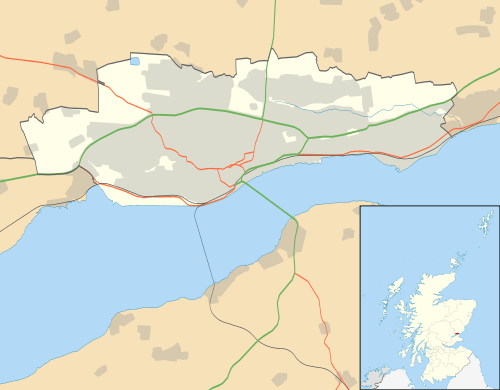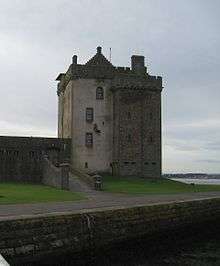Broughty Ferry
Broughty Ferry
| |
|---|---|
|
| |
 Broughty Ferry Broughty Ferry shown within the City of Dundee | |
| Population | 13,155 |
| OS grid reference | NO465309 |
| Council area | |
| Lieutenancy area | |
| Country | Scotland |
| Sovereign state | United Kingdom |
| Post town | DUNDEE |
| Postcode district | DD5 |
| Dialling code | 01382 |
| Police | Scottish |
| Fire | Scottish |
| Ambulance | Scottish |
| EU Parliament | Scotland |
| UK Parliament | |
| Scottish Parliament | |
Broughty Ferry (/ˈbrɒti/; Scottish Gaelic: Bruach Tatha; Scots: Brochtie) is a suburb in Dundee, Scotland. It is situated four miles east of the city centre on the north bank of the Firth of Tay. The area was a separate burgh from 1864 until 1913, when it was incorporated into Dundee.
Formerly a prosperous fishing and whaling village, in the 19th century Broughty Ferry became a haven for wealthy jute barons, who built their luxury villas in the suburb. As a result, Broughty Ferry was referred to at the time as the "richest square mile in Europe".
It is administered as part of the Dundee City council ward. At a national level, it is represented by both the UK Parliamentary constituency of Dundee East and the Scottish Parliamentary constituency of Dundee City East.
Several road and rail routes are located within the area; Broughty Ferry railway station is situated in the center of the suburb, and the A930 road skirts its main retail area. Broughty Ferry is also linked by several bus routes to its neighbouring suburbs and to central Dundee.
Toponymy
The name Broughty Ferry may derive from Bruach Tatha meaning "Taybank" in Scottish Gaelic. A piece of folk etymology holds that the name derives from the Lowland Scots broch, meaning some form of fortification, with the 'ty' being a shortening of the name of the River Tay, and Ferry being added later in recognition of the town's role as a ferry port. However, this is unlikely, as the word order would probably be "Tay Broch", rather than "Broch Tay".
History

Evidence exists of a human settlement in pre-historic times, later developing into a prosperous fishing and whaling village, before becoming home to 19th century jute barons who had their factories in Dundee.[2] At this time it was known as the 'richest square mile in Europe'.[3]
In 1495 Broughty Castle was built and remained in use as a major defensive structure until 1932, playing a role in the Anglo-Scottish Wars and the Wars of the Three Kingdoms. The castle stands on a shallow tip projecting into the Firth, alongside two beaches, one of sand, the other of pebbles.
Additionally an English fort was located on what is now known as Forthill. Fortified around 1548 and demolished in 1550, no trace of this now survives due to the development of later buildings and gardens. However it was recorded in 1845 that less than 60 years earlier some of the walls still stood.[4] The castle was bought by the government and restored during 1860-1.[2]
The area has two Category A listed buildings, St Stephen’s Church (the parish church of the West Ferry) and St Luke’s Church built in the 19th century. St Stephen’s has exceptionally fine Victorian windows thought to be the best collection of Edward Burne-Jones stained glass in Scotland.
Prior to the construction of the first Tay Rail Bridge in 1878, a roll-on/roll-off railway ferry linked the Edinburgh to Aberdeen railway line between Tayport and Broughty Ferry, until the construction of the rail bridge made it redundant.
Broughty Ferry was incorporated into the City of Dundee in 1913.[5]
On 2 December 1943, a pigeon from Broughty Ferry called Winkie was awarded the Dickin Medal for "delivering a message under exceptional difficulties and so contributing to the rescue of an Air Crew while serving with the RAF in February 1942".
On 8 December 1959 the town's lifeboat, the RNLB Mona, was lost with all hands attempting to rescue a foundering lightship.
Education
There are three primary schools located in Broughty Ferry. They are: Barnhill Primary School, Forthill Primary School and Eastern Primary School. Pupils living in the Barnhill Area will most likely go to Barnhill Primary School, pupils living in central Broughty Ferry will most likely go to Eastern Primary School and pupils living West Ferry will most likely go to Forthill Primary School. All three of these primary schools are feeder schools for Grove Academy.
Grove Academy (high school) has been rebuilt and opened in late 2009. Eastern Primary School has moved into the old Grove building. Formerly, pupils who live in the Barnhill area had the option to attend the Angus school, Monifieth High School, although the option was later withdrawn, in 1 January 2009.
Facilities
Broughty Ferry has a renovated park at the beachfront which includes a number of facilities, such as crazy golf, a large play park and water park and children's go-karts. On New Year's Day there is a tradition of swimming between the piers of the harbour. A limited train service is available from the railway station.
Culture
Broughty Ferry is the setting for the Bob Servant books and BBC radio and television[6] series written by Neil Forsyth.
Sport
Broughty Ferry is home to the junior football club Broughty Athletic F.C. Broughty Athletic play at Whitton Park which is located in Arbroath Road, adjacent to Douglas Sports Centre and opposite Claypotts Castle. Broughty Athletic play in the ACA Sports East Region Premier League and many of their opponents are from Fife and the Lothians.
The majority of sports activity takes place in Dawson Park which boasts a number of fields and facilities. The park has five football pitches, a rugby union pitch, an American football pitch and several athletics facilities. In 2006, a new all-weather pitch with floodlights was opened, and is used by the nearby Grove Academy.
Broughty Ferry is also home to two Bowling Clubs: Broughty BC and Broughty Castle BC. Both clubs are open all year round, and their outdoor bowling season runs from April to September.
Panmure Rugby FC (est.1880) has its home at Forthill Sports Club.
Broughty Ferry has two tennis clubs, one of which – Broughty Ferry Tennis Club – is open all year round and has six all-weather floodlit courts. The other is Forthill Tennis Club, which has six clay courts and a playing season between April and October.
Cricket is played at Forthill Sports Club in Fintry Place, Broughty Ferry, the home of Forfarshire Cricket Club. The ground, also known as Forthill, Dundee was purchased in 1880 by a group of city merchants led by George M. Cox.
Army Cadet Force
Broughty Ferry is home to Grove Black Watch which is part of Cambrai company in the Angus and Dundee Battalion of the Army Cadet Force. It is a youth organisation which is almost 150 years old.
Notable residents
Sportspeople that have associations with Broughty Ferry include international footballers Frank Munro and Peter Lorimer and the former Scottish international rugby union captain Sir George Cunningham. Other notable individuals with connections to Broughty Ferry include the minister and scientist Thomas Dick, the Victoria Cross recipient Hugh Malcolm, and the cartoonist Dudley D. Watkins.
References
- ↑ Scots Language Centre: Scottish Place Names in Scots
- 1 2 Francis H Groome, ed. (1885). Ordnance Gazetteer of Scotland: A Survey of Scottish Topography, Statistical, Biographical and Historical. Thomas C. Jack.
- ↑ Dolman, Hannah (4 March 2016). "Bid to make Broughty Ferry into a tourist hotspot". Evening Telegraph. Retrieved 31 August 2018.
- ↑ "Broughty Ferry, Fort Hill". Canmore. Historic Environment Scotland. Retrieved 23 January 2017.
- ↑ "Broughty Ferry: Overview". Gazetteer for Scotland. Retrieved 31 August 2018.
- ↑ BBC 4: Bob Servant: Independent
External links
| Wikisource has the text of the 1911 Encyclopædia Britannica article Broughty Ferry. |